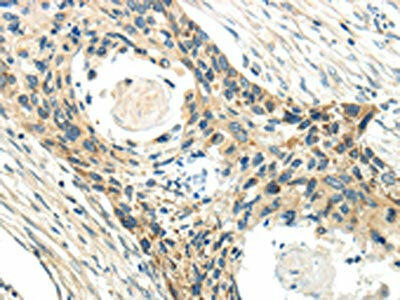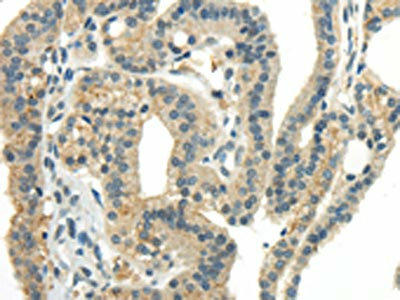CCL13 Antibody (PACO17662)
- SKU:
- PACO17662
- Product Type:
- Antibody
- Reactivity:
- Human
- Host Species:
- Rabbit
- Isotype:
- IgG
- Applications:
- ELISA
- IHC
- Antibody Type:
- Polyclonal Antibody
- Conjugation:
- Unconjugated
Description
CCL13 Antibody (PACO17662)
The CCL13 Polyclonal Antibody (PAC017662) is a vital tool for researchers studying chemokine C-C motif ligand 13 (CCL13), a signaling protein involved in immune cell migration and inflammation. This antibody, generated in rabbits, exhibits high specificity and sensitivity towards human samples, making it an excellent choice for Western blot applications. By targeting the CCL13 protein, researchers can effectively study its expression and function in various cell types, aiding in the advancement of immunology and inflammatory disease research.
CCL13, also known as monocyte chemotactic protein 4 (MCP-4), plays a crucial role in recruiting monocytes and lymphocytes to sites of inflammation, contributing to the immune response. Its involvement in inflammatory processes makes it a promising target for investigating diseases such as asthma, arthritis, and atherosclerosis. By studying CCL13 with this antibody, researchers can gain valuable insights into the mechanisms underlying these conditions and potentially identify new therapeutic strategies for treating them.
| Antibody Name: | CCL13 Antibody (PACO17662) |
| Antibody SKU: | PACO17662 |
| Size: | 50ul |
| Host Species: | Rabbit |
| Tested Applications: | ELISA, IHC |
| Recommended Dilutions: | ELISA:1:2000-1:10000, IHC:1:30-1:150 |
| Species Reactivity: | Human |
| Immunogen: | Synthetic peptide of human CCL13 |
| Form: | Liquid |
| Storage Buffer: | -20°C, pH7.4 PBS, 0.05% NaN3, 40% Glycerol |
| Purification Method: | Antigen affinity purification |
| Clonality: | Polyclonal |
| Isotype: | IgG |
| Conjugate: | Non-conjugated |
 | The image on the left is immunohistochemistry of paraffin-embedded Human esophagus cancer tissue using PACO17662(CCL13 Antibody) at dilution 1/40, on the right is treated with synthetic peptide. (Original magnification: x200). |
 | The image on the left is immunohistochemistry of paraffin-embedded Human thyroid cancer tissue using PACO17662(CCL13 Antibody) at dilution 1/40, on the right is treated with synthetic peptide. (Original magnification: x200). |
| Background: | This gene is one of several Cys-Cys (CC) cytokine genes clustered on the q-arm of chromosome 17. Cytokines are a family of secreted proteins involved in immunoregulatory and inflammatory processes. The CC cytokines are proteins characterized by two adjacent cysteines. The cytokine encoded by this gene displays chemotactic activity for monocytes, lymphocytes, basophils and eosinophils, but not neutrophils. This chemokine plays a role in accumulation of leukocytes during inflammation. It may also be involved in the recruitment of monocytes into the arterial wall during artherosclerosis. |
| Synonyms: | C-C motif chemokine 13 |
| UniProt Protein Function: | CCL13: Chemotactic factor that attracts monocytes, lymphocytes, basophils and eosinophils, but not neutrophils. Signals through CCR2B and CCR3 receptors. Plays a role in the accumulation of leukocytes at both sides of allergic and non-allergic inflammation. May be involved in the recruitment of monocytes into the arterial wall during the disease process of atherosclerosis. May play a role in the monocyte attraction in tissues chronically exposed to exogenous pathogens. By IL1/interleukin-1 and TNF. Widely expressed. Found in small intestine, thymus, colon, lung, trachea, stomach and lymph node. Low levels seen in the pulmonary artery smooth muscle cells. Belongs to the intercrine beta (chemokine CC) family. |
| UniProt Protein Details: | Protein type:Secreted, signal peptide; Motility/polarity/chemotaxis; Chemokine; Secreted Chromosomal Location of Human Ortholog: 17q11.2 Cellular Component: extracellular space Molecular Function:chemokine activity; receptor binding Biological Process: cellular calcium ion homeostasis; regulation of cell shape; cell-cell signaling; eosinophil chemotaxis; cytoskeleton organization and biogenesis; immune response; signal transduction; inflammatory response; chemotaxis |
| NCBI Summary: | This antimicrobial gene is one of several Cys-Cys (CC) cytokine genes clustered on the q-arm of chromosome 17. Cytokines are a family of secreted proteins involved in immunoregulatory and inflammatory processes. The CC cytokines are proteins characterized by two adjacent cysteines. The cytokine encoded by this gene displays chemotactic activity for monocytes, lymphocytes, basophils and eosinophils, but not neutrophils. This chemokine plays a role in accumulation of leukocytes during inflammation. It may also be involved in the recruitment of monocytes into the arterial wall during artherosclerosis. [provided by RefSeq, Sep 2014] |
| UniProt Code: | Q99616 |
| NCBI GenInfo Identifier: | 3024128 |
| NCBI Gene ID: | 6357 |
| NCBI Accession: | Q99616.1 |
| UniProt Related Accession: | Q99616 |
| Molecular Weight: | |
| NCBI Full Name: | C-C motif chemokine 13 |
| NCBI Synonym Full Names: | C-C motif chemokine ligand 13 |
| NCBI Official Symbol: | CCL13 |
| NCBI Official Synonym Symbols: | NCC1; CKb10; MCP-4; NCC-1; SCYL1; SCYA13 |
| NCBI Protein Information: | C-C motif chemokine 13 |
| UniProt Protein Name: | C-C motif chemokine 13 |
| UniProt Synonym Protein Names: | CK-beta-10; Monocyte chemoattractant protein 4; Monocyte chemotactic protein 4; MCP-4; NCC-1; Small-inducible cytokine A13Cleaved into the following 3 chains:C-C motif chemokine 13, long chain; C-C motif chemokine 13, medium chain; C-C motif chemokine 13, short chain |
| Protein Family: | Meiotic coiled-coil protein |
| UniProt Gene Name: | CCL13 |
| UniProt Entry Name: | CCL13_HUMAN |
| Secondary Antibody |
| Anti-HRP Goat Anti-Rabbit IgG (H+L) Antibody (CABS014) |
| Recommended Products |
| Anti-FITC Goat Anti-Rabbit IgG (H+L) Antibody (CABS011) |
| Anti-HRP-conjugated Beta Actin Antibody (CABC028) |












